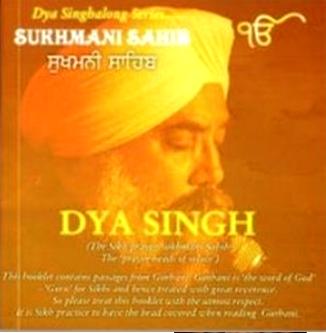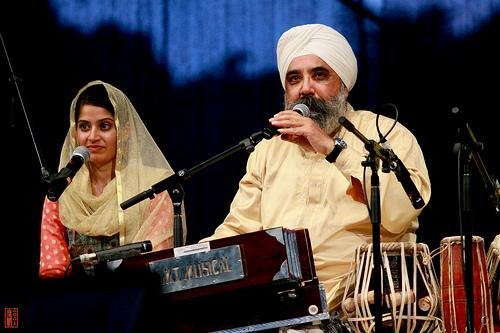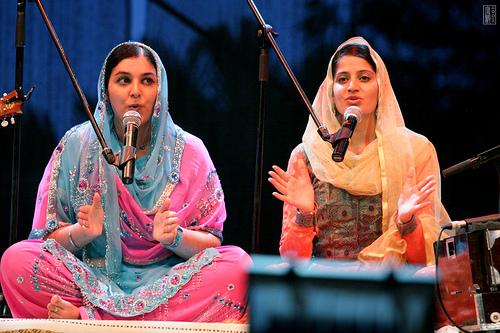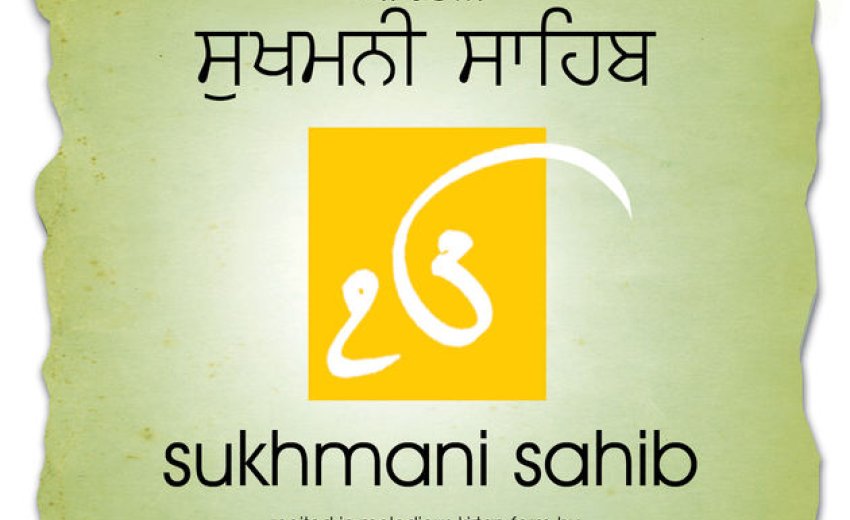 It was pure chance meeting S. Dya Singh of Australia in his own hometown, Taiping, Perak, Malaysia, as prior arrangements to meet him did not materialise. But then, it was, as ordained. A chance in a million meeting at an off the track swimming spot on a river in the Taiping foothills called the Burmese Pool! I believe meeting and departing in life all happens under His Hukam (Command). Bhai Sahib was kind enough to present me with a gift of a pack of double CDs of Sukhmani Sahib.
It was pure chance meeting S. Dya Singh of Australia in his own hometown, Taiping, Perak, Malaysia, as prior arrangements to meet him did not materialise. But then, it was, as ordained. A chance in a million meeting at an off the track swimming spot on a river in the Taiping foothills called the Burmese Pool! I believe meeting and departing in life all happens under His Hukam (Command). Bhai Sahib was kind enough to present me with a gift of a pack of double CDs of Sukhmani Sahib.
(CD1 comprises Stanzas 1 to 12 and CD2 Stanzas 13-24) including a 'Sunder Gutka'. To make this dream come true, Dya Singh Ji had considerable inspiration and sponsorship from others, many who wish to remain anonymous. Anonymity goes down well in Sikhi, as the faith advocates humility, and nishkam sewa to the community. Not looking for any recognition, sits well in the gracious laps of Waheguru.
The CDs are neatly packed with a compact pocket-size Gutka of Sukhmani Sahib, 'The prayer beads of solace' in Gurmukhi, romanised version and transliteration by S Harminderpal Singh of Singapore included. What a lovely thought for others to be focused, and follow the 'paath' visually as it is recited. It even gets better - on the Gutka, a serene and tranquil picture of Bhai Sahib immersed in naam simran; totally exemplifies peace and equipoise. The aim is to bring solace to many and encourage everyone to recite Sukhmani Sahib on a regular basis for very strong reasons - to wipe out any maladies, adverse challenges in life and even change the destiny/fate of others as stated, in an adjunct to the CDs,
I also recommend that listeners, take time out to listen to eight and a half hours of 'Sri Sukhmani Sahib Diya Visheshtaian' by Bhai Guriqbal Singh of Gurdwara Mata Kaula of Amritsar. The viakhya (sermons) with anecdotal 'janamsakhis' is an eye opener and it does drive home the point, that the miracle of Sukhmani Sahib to wipe out any difficulties is not to be underestimated. S. Dya Singh’s aim is to get this succinct message across to the listeners, especially youth to contemplate on the Bani - making Waheguru the physician for major ailments. (Mera baidh Guru Gobindha...)
 S. Dya Singh Ji's 'Gurmat Sangeet' (Sikh spiritual music) inspiration came from his parents (Giani Harchand Singh Bassian and Madam Harminder Kaur) who nurtured him in the right sphere. He inherited his father’s love and the gift of core Sikh spiritual values and Gurmat Sangeet. He is originally from Taiping - a Chinese word meaning “peace”, coincidental that this review has to be on Sukhmani Sahib, the Psalm of Peace. He completed his school education in Malaysia and spent 11 years in the UK studying and working as an accountant. In 1981, he decided to migrate to Australia with his wife, Jasbir Kaur (Jessiee) and Waheguru blessed them with three talented daughters with good vocals constantly performing with their father adding a sparkle to the soothing kirtan appreciated by millions. S. Dya Singh attributes his unique musical talent to his birth and formative years in multi-religious and multicultural Malaysia, his venerable father and legendary 'ragis' of the Sikh faith. His achievements are phenomenal and he has pioneered over 20 albums including this most recent Sukhmani Sahib in kirtan.
S. Dya Singh Ji's 'Gurmat Sangeet' (Sikh spiritual music) inspiration came from his parents (Giani Harchand Singh Bassian and Madam Harminder Kaur) who nurtured him in the right sphere. He inherited his father’s love and the gift of core Sikh spiritual values and Gurmat Sangeet. He is originally from Taiping - a Chinese word meaning “peace”, coincidental that this review has to be on Sukhmani Sahib, the Psalm of Peace. He completed his school education in Malaysia and spent 11 years in the UK studying and working as an accountant. In 1981, he decided to migrate to Australia with his wife, Jasbir Kaur (Jessiee) and Waheguru blessed them with three talented daughters with good vocals constantly performing with their father adding a sparkle to the soothing kirtan appreciated by millions. S. Dya Singh attributes his unique musical talent to his birth and formative years in multi-religious and multicultural Malaysia, his venerable father and legendary 'ragis' of the Sikh faith. His achievements are phenomenal and he has pioneered over 20 albums including this most recent Sukhmani Sahib in kirtan.
Nearing 60 years of age, Bhai Sahib's incredible voice remains well controlled and he sings with so much of 'shardha' that it pierces the heart of the listener. His voice is not too dissimilar to the great artiste Mannadey, whose golden tracks are still alive and reverberating in the hearts of others. Dya Singh Ji has proven ability and has demonstrated to the music world, his innovative approach to kirtan, by experimenting with other non-Sikh musicians and musical instruments, such as the didgeridoo, bouzouki, violin and even the Irish bohdran. It is a unique approach to kirtan unlike those Ragi Jathas from the sub-continent India arriving at Gurdwaras with standard one tabla and two harmoniums. It is this unique approach that has captured the interest of the young and old Sikh and non-Sikh audiences worldwide.
 Bhai Sahib and his dynamic team have produced these excellent CDs to reach the hearts of others. In this rendition of Sukhmani Sahib in kirtan, the 'Gurbani' is very clearly articulated with clear emphasis on each 'salok' and 'astpadhi' which in itself has it's own impact. The 'dilruba' inaugurates each shalok which adds a serene dimension and inspires others to listen to the CDs in their entirety. It is indeed a serene spiritual journey to experience. The musical instruments have been used effectively but instrumentation has been deliberately kept to a minimum so that the focus is on the divinity of the Gurbani itself. Sukhmani Sahib Kirtan was conceptualised to enhance the spiritual message of Gurbani and to induce a mood of meditation and spiritual equipoise (sehaj anand)
Bhai Sahib and his dynamic team have produced these excellent CDs to reach the hearts of others. In this rendition of Sukhmani Sahib in kirtan, the 'Gurbani' is very clearly articulated with clear emphasis on each 'salok' and 'astpadhi' which in itself has it's own impact. The 'dilruba' inaugurates each shalok which adds a serene dimension and inspires others to listen to the CDs in their entirety. It is indeed a serene spiritual journey to experience. The musical instruments have been used effectively but instrumentation has been deliberately kept to a minimum so that the focus is on the divinity of the Gurbani itself. Sukhmani Sahib Kirtan was conceptualised to enhance the spiritual message of Gurbani and to induce a mood of meditation and spiritual equipoise (sehaj anand)
It is riveting and it is difficult to renounce this wonderful synchronisation of his music, his calming voice and the sweet voices of his daughters. Each shabad is clearly articulated and more so - with love and joy for the 'Bani'. The shabads are sung with different morning raags and the pitch of the voice and the synchronisation with the vocals of his daughters is enchanting; never a dull moment!
Sukhmani Sahib is supreme. It is recommended that Sukhmani Sahib is recited and heard on daily basis and this aptly named DyaSinghalong series actually simplifies and enables listeners to grasp each shabad with easy reference to the Gutka. It makes life easy by understanding the true essence of the Sukhmani Sahib. One has to accept his 'Bhana' (law), and live in 'sat, santokh and veechaar' (truth, contentment and contemplation of Naam) and peace, totally surrendering to the 'Hukam' (Will) of God.
The rendition starts and ends with Raag Gauri Sukhmani in which the Sukhmani Sahib is rendered by Sri Guru Arjan Dev Ji. This rendition also has various musical pitches and raags including other morning raags like Raag Assa, Ramkali and Todi - just to mention a few. Bhai Sahib is no ordinary soul and he includes a crew of wonderful instrumentalist to give a good uplifting lilt to the kirtan. Special attention was made towards making sure that the 'paath' was clear and easily followed. Different 'taals' have been used so that the paath remains eventful and practically 'realises' itself to the listener. The versatile instruments he uses in doing his kirtan enhances the universal spiritual messages of truth, love, peace, harmony, equality and justice. Furthermore, he lives up to his name and the compassion he exudes musically and in his social interaction with others. He radiates warmth, dhiraj (patience), nimrata (humility), warmth and empathy.
 This monumental rendition appears to be a very conscious attempt by Bhai Sahib to use his team and the talented voice of his three youthful voices of his daughters Jamel, Harsel and Parvyn Kaur to appeal to the youth and inspire them to get in close proximity with the Sri Guru Granth Sahib Ji. It is recommended that Dya’s Singhalong CD will enable listeners to get a grasp of the 'paath' and by listening to it on daily basis will help one to familiarise oneself with the shabads and the listener will start learning it by heart. The importance of daily recitation is important and once mastered it is a divine wealth when one can recite whilst standing up or sitting down, meditating ever on Him.
This monumental rendition appears to be a very conscious attempt by Bhai Sahib to use his team and the talented voice of his three youthful voices of his daughters Jamel, Harsel and Parvyn Kaur to appeal to the youth and inspire them to get in close proximity with the Sri Guru Granth Sahib Ji. It is recommended that Dya’s Singhalong CD will enable listeners to get a grasp of the 'paath' and by listening to it on daily basis will help one to familiarise oneself with the shabads and the listener will start learning it by heart. The importance of daily recitation is important and once mastered it is a divine wealth when one can recite whilst standing up or sitting down, meditating ever on Him.
It is also very useful to ponder upon what others have said about Sukhmani Sahib and a few excerpts from Sukhmani Sahib will distill some of the thoughts and messages to the listeners. Gurbani is appreciated if the shabads are understood and assimilated in one’s life style. Various scholars have given emphasis to Sukhmani Sahib. Bhai Vir Singh Ji stated that it is the gem that brings peace to mind. Bhai Teja Singh Singh Ji further writes that Sukhmani Sahib is “designed to stir the depth of human nature and to start a current-like religious motion that will cleanse and stimulate our tiny selves and unite us with the source of existence or transcendence. Professor Puran Singh views this message of Sukhmani of Guru Arjan Dev Ji as a river of peace in which we can dip our soul. Bhai Dya Singh describes it as 'the prayer beads of solace'
Guru Arjan Dev Ji composed Sukhmani Sahib following request by a devotee who was suffering from physical and mental anguish. Sukhmani Sahib has been glorified by many famous scholars and it means the Psalms of equipoise or the Jewel of Bliss. Sukhmani Sahib contains 24,000 shabads as a person reputedly takes 24,000 breaths (swas) day and night in a given day. The Bani is considered a cure for all ailments and is recited to those who are sick and have intractable problems such as cancer and terminal illnesses.
Sukhmani Sahib consist of 24 Ashtapadis and 24 Shaloks. Each Ashtapadis contain 8 stanzas and each stanza contains 10 'tukas' (lines). It contains one Rahau, meaning Pause at the end of the first stanza of the first Ashtapadis. It is generally accepted that Waheguru-inspired Sukhmani Sahib was composed during 1601-1604, at Ramsar, Amritsar under a Pipal tree. Guru Arjan Dev Ji composed Sukhmani Sahib at Amrit Vela for the sake of humanity in Kalyug.
Sukhmani Sahib, the Divine Hymn, advocates that to seek salvation, Naam should be uttered and to do so one has to imbibe some of the divine virtues such as humility, surrendering oneself to Waheguru and by His Grace, this becomes possible. The Bani also advocates the company of the Saints and attributes of brahamgian (the divine wisdom) and the sargun (the manifest possessing all physical attributes) and nirgun, (the non-manifest which is formless and abstract). In a nutshell, the seeker of the truth gathers the wealth of Naam whilst not only listening to Dya Singhalong Sukhmani Sahib but also immersing oneself in the 'Bani' and letting the mind soak in it to partake of its purity and divinity. Waheguru is the treasure of virtues and by reciting, many gifts are obtained, such as eternal joy and peace, the nine treasures, divine wisdom, knowledge, spiritual powers. Naam is the gem of all comforts.
Excerpts from Sukhmani Sahib will bring to surface, the core of the divine knowledge and the message to all listeners and devotees. The message that by listening and understanding Sukhmani Sahib will ingrain in the devotee a senses of sacrifice, humility, divine virtues and achieve internal bliss or joy by 'liv Jaap' (sustained and focused recitation) that will permeate every pore in the body - a feeling that is indescribable and a choice above wretched materialism and worldly attachments.
“Sukhi basai maskinia ap (u) nivar (i) tale; Bade bade ahankaria Nanak garab gale”
(He, who is humble and effaces his self, lives a happy lie. But the proud ones, who may be very big in a status are consumed by their pride, says Guru Nanak.)
“Kar(i) kirpa jis kai hirdai garibi basavai; Nanak iha mukat(u) agai such(u) pavai.”
(He, in whose heart God causes humility to reside; shall get salvation in this world, and shall get divine peace in the God’s court, says Nanak)
“Bhala bhala bhala tera rup; at(i) sundar apar anup. Nirmal nirmal nirmal teri Bani; ghat(i) ghat(i) suni sraven bakhyani”
(O God, Excellent, excellent, excellent, is Your Form ;( And You are) Exquisitively, beautiful, boundless and incomparable
Pure, pure, pure is your word (Divine Hymn); when uttered or heard, it settles every mind)
“Charan chalo marag (i) Gobind; Miteh pap japia Har (i) bind”
(Walk with your feet in the way of God; By remembering God for a moment, all sins are erased.)
“Charan sadh ke dhoe dhoe pio; Arap (i) sadh kau apna jio”
(Wash the feet of the Guru with water and drink it afterwards; Sacrifice (dedicate) your soul to the Guru)
“Jio jal maih jal(u) ae khatana; Tis joti sang(i) jot(i) samana; Mit(i) gae pae bisram; Nanak Prabh kai kurban”
(As water blends with water, so the light (soul) (of such devotee) merges in the Divine light (Supreme Soul); thus, transmigration is effaced and the True rest (in God’s place or Dargah) is obtained. Guru Nanak says, I am ever and ever a sacrifice to God)
“Sukhmani sahaj Gobind gun Naam; Jis(u) man(i) basai su hot nidhan.”
(The Sukhmani is in fact, equipoise giving the Name of God and His Attributes; He, in whose heart it dwells shall become the embodiment of divine virtues.)
Sukhmani Sahib summarises this life purpose beautifully and the message is clear as a bell: He, in whose heart resides the Divine Naam or who listens to it with devotion; (Such One) ever remembers God, The True Lord. God will remove his pains of birth and death; the rare human life is saved in a moment. He earns true fame, and nectar flows from his words and God’s name alone is absorbed in his mind.
“Dukh rog binse bahi bharam; Sadh naam nirmal ta ke karam.
Sabh te uch taki sobha bani: Nanak eh gun(i) Naam(u) Sukhmani.”
(Grief, disease and duality, all these vanish; He is called a saint (and) his deeds become virtuous. His fame shall be the most exalted of all. By virtue of this attribute, Divine Name is termed as Psalm of Peace.)
As Sukhmani Sahib, clearly says that to wipe out grief, disease and duality and to be in connection with Waheguru by the utterance of Naam, one must commit oneself to Sukhmani Sahib and you will reap the benefits. That is the ultimate message from the Gurbani and thanks to Dya Singhalong Sukhmani Sahib which captures all the shabads in a clear and melodious recitation with uplifting music that will induce anyone to slip away into meditation with positive outcome whereby, the simran pierces the mind with Naam achieving sahaj avastha.
This double album far supersedes Bhai Sahib's earlier music album of selected passages from Sukhmani Sahib called 'Sukhmani Simran'. That was recorded as a background to doing ones own simran or yoga. This, is the 'real thing'!
The CD set can be purchased from Spirit Voyage Music, but for your own personally signed copy which I highly recommend please contact S. Dya Singh Ji through his website www.dyasingh.com or email [email protected]
